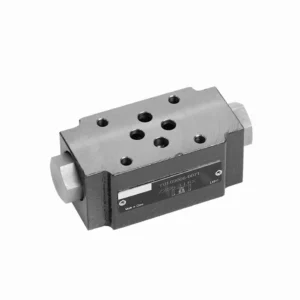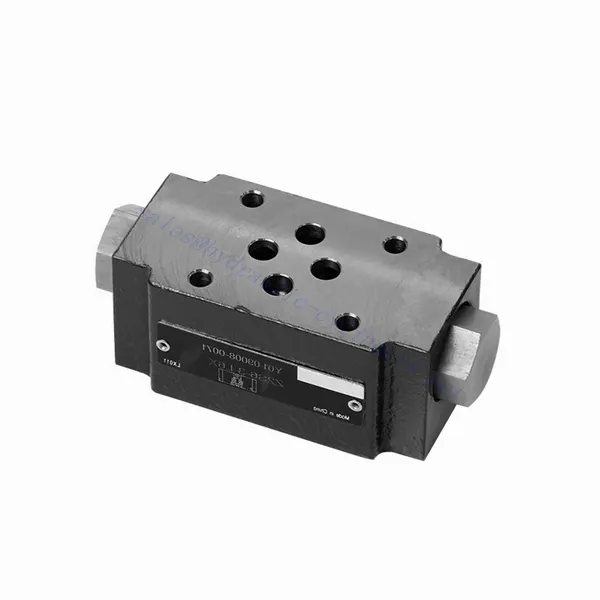Z2S Series Pilot Operated Check Hydraulic Valve
Z2S Series Pilot Operated Check Hydraulic Valve

The Z2S series pilot operated check hydraulic valve is a cutting-edge solution designed to optimize the performance and control of hydraulic systems. With its advanced design and versatile features, this valve enhances fluid flow management, ensuring efficient and reliable operation.
The Z2S series pilot operated check hydraulic valve is an essential component for hydraulic systems, offering precise control, high flow capacity, and reliable check functionality. With its pilot operated design and pressure control capabilities, it optimizes fluid flow and enhances system performance. By following the recommended usage methods and adhering to regular maintenance practices, the Z2S series valve will continue to provide efficient and reliable operation. Upgrade your hydraulic system with the Z2S series pilot operated check hydraulic valve and experience the benefits of enhanced control and efficiency.
Z2S Series Pilot Operated Check Hydraulic Valve Key Characteristics:
- Pilot Operated Design:
- The Z2S series valve incorporates a pilot-operated mechanism that enables precise control over fluid flow.
- This design allows for enhanced accuracy and responsiveness, ensuring optimal system performance.
- Check Functionality:
- The valve features a built-in check function that allows unidirectional fluid flow while preventing backflow.
- This ensures system integrity and prevents potential damage, providing peace of mind during operation.
- High Flow Capacity:
- The Z2S series hydraulic valve is engineered to handle high flow rates, making it suitable for efficient fluid control applications.
- Its optimized flow path minimizes pressure drop, maximizing system efficiency and reducing energy consumption.
- Pressure Control:
- This hydraulic valve offers precise pressure control capabilities, allowing for managing pressure levels within the hydraulic system.
- It ensures stability and reliability by maintaining consistent pressure, even under varying load conditions.
Z2S Series Pilot Operated Check Hydraulic Valve Parameter:
| Size | 6 | 10 | 16 | 22 | |
| Fluid | Mineral oil suitable for NBR and FKM seal | ||||
| Phosphate ester for FKM seal | |||||
| Degree of contamination | Maximum permissible degree of fluid contamination: Class 9. NAS 1638 or 20/18/15, ISO4406 | ||||
| Fluid temperature range ℃ | -30 to +80(NBR seal) | ||||
| -20 to +80(FKM seal) | |||||
| Viscosity rangemm2/s | 2.8 to 500 | ||||
| Operating pressure bar | 315 | ||||
| Max. flow-rateL/min | 60 | 120 | 300 | 450 | |
| Flow direction | See the sign | ||||
| Crack pressure(positive circulation) bar | Refer to the characteristic curve | 1.5,3,6,10 | 0.3,0.5,0.75,1.0 | 3,5,7.5,10 | |
| Area radio | A1/A2=1/3 | A1/A2=1/13.4 A3/A2=1/2.68 (Please refer to page”02/04″for section drawing) | A1/A2=1/11.8 A3/A2=1/2.8 (Please refer to page”02/04″for section drawing) | A1/A2=1/13.6 A3/A2=1/2.8 | |
| Weightkg | about 1.0 | 3 | 6.8 | 12.8 | |
Z2S Series Pilot Operated Check Hydraulic Valve Advantages:
NG6
• Sandwich type structure
• Installation face follow DIN 24340 A, ISO 4401, CETOP-RP121H
• One or two sets of working oil orifices leak free sealing according to requirements
• Applied for sandwich type installation
• Three opening pressure
NG10
• Connection size follow DIN 24340
• Have one or two leak free sealingports
• Sandwich type structure, used in vertical sandwich type installation
• Four opening pressure, optional
NG16
• Connection size follow DIN 24340
• Have one or two leak free sealingports
• Sandwich type structure, used in vertical sandwich type installation
• Four opening pressure, optional
NG22
• Connection size follow DIN 24340
• Have one or two leak free sealingports
• Sandwich type structure, used in vertical sandwich type installation
• Four opening pressure, optional
Usage Method Of Z2S Series Pilot Operated Check Hydraulic Valve:
- System Integration:
- Identify the appropriate location for the Z2S series valve within the hydraulic system, considering the desired flow direction and pressure control requirements.
- Ensure compatibility with the system’s pressure and flow specifications.
- Install the valve in-line with the fluid flow, following the manufacturer’s guidelines.
- Pilot Connection:
- Connect the pilot line to an external control device, such as a pressure relief valve or a proportional pressure control valve.
- Ensure proper sizing and connections to enable accurate pressure regulation.
- Fluid Connections:
- Select compatible hydraulic fittings and hoses for secure and leak-free connections.
- Follow the manufacturer’s instructions for proper torque values during the installation process.
- Use appropriate thread sealants or tape to ensure a reliable seal.
- System Calibration:
- Calibrate the pilot control device according to the desired pressure settings and system requirements.
- Adjust the control parameters to achieve the desired pressure regulation and response characteristics.
How To Bleed A Hydraulic Clutch Without Bleeder Valve?
Bleeding a hydraulic clutch without a bleeder valve can be a bit more challenging, but it is still possible. Here’s a step-by-step guide on how to bleed a hydraulic clutch without a bleeder valve:
- Safety Precautions:
- Prioritize safety by wearing appropriate personal protective equipment, including gloves and safety glasses.
- Make sure the hydraulic system is depressurized. Turn off the engine and ensure the clutch pedal is not depressed.
- Locate the Clutch Slave Cylinder:
- Identify the location of the clutch slave cylinder. It is usually mounted on or near the transmission bell housing and connected to the clutch release mechanism.
- Prepare the Tools:
- Gather the necessary tools, including an open-end wrench or line wrench that fits the hydraulic line fittings, a clean container to collect the old fluid, and fresh hydraulic clutch fluid.
- Access the Hydraulic Line:
- Locate the hydraulic line connected to the clutch slave cylinder.
- Loosen the fittings at both ends of the hydraulic line using the appropriate wrench.
- Place the container beneath the line to catch any fluid that may leak out during the bleeding process.
- Gravity Bleeding:
- Fill the clutch master cylinder reservoir with fresh hydraulic clutch fluid.
- Leave the fittings loose and allow the fluid to gravity bleed by letting it flow from the clutch master cylinder, through the hydraulic line, and into the container.
- Keep an eye on the fluid level in the master cylinder reservoir, ensuring it remains topped up during the bleeding process.
- Manual Bleeding:
- Once the fluid flows steadily and is free of air bubbles, it’s time to bleed the hydraulic clutch manually.
- Enlist the help of a second person to operate the clutch pedal while you monitor and manipulate the hydraulic line fittings.
- Instruct the person to depress the clutch pedal and hold it down slowly.
- Open and Close the Fittings:
- As the person holds the clutch pedal down, quickly open and close the fitting at the clutch slave cylinder end of the hydraulic line.
- This action creates pressure and forces trapped air bubbles to move towards the open fitting.
- Repeat the Process:
- Repeat the process of opening and closing the fitting multiple times while the clutch pedal is held down to expel any remaining air bubbles.
- Ensure that the person operating the clutch pedal releases it only after you have closed the fitting securely.
- Tighten the Fittings:
- Once the manual bleeding process is complete, tighten the hydraulic line fittings at both ends using the wrench.
- Ensure they are securely tightened to prevent any leaks.
- Test the Clutch:
- Start the engine and test the clutch pedal for proper operation.
- Depress and release the clutch pedal several times to ensure smooth engagement and disengagement.
- Ongoing Maintenance:
- Regularly check the clutch fluid level and inspect the system for any signs of leaks or air accumulation.
- If you notice recurring air in the system or experience difficulties with the clutch, it’s recommended to seek assistance from a qualified professional to identify and resolve any underlying issues.
工厂的能力和产能:
(1) 装配
我们拥有一流的自主研发装配平台。液压油缸生产车间拥有 4 条半自动提升油缸装配线和 1 条全自动倾斜油缸装配线,设计年生产能力 100 万支。特种油缸车间配备了各种规格的半自动清洗装配系统,设计年生产能力 20 万只,并配备了知名数控加工设备、加工中心、高精度油缸加工专用设备、机器人焊接机、自动清洗机、油缸自动装配机、自动喷漆生产线等。现有关键设备 300 多台(套)。设备资源的优化配置和高效利用,保证了产品的精度要求,满足了产品的高质量需求。


(2) 机加工
加工车间配备了定制的斜轨车削中心、加工中心、高速珩磨机、焊接机器人及其他相关设备,可加工最大内径 400 毫米、最大长度 6 米的气缸管。

(3) 焊接

(4) 油漆和涂料
配备中小型圆筒自动水性漆喷涂线,实现机器人自动上下料和自动喷涂,设计产能为每班 4000 件;
我们还拥有一条由动力链驱动的大型油缸半自动喷漆生产线,设计产能为每班 60 箱。


(5) 测试
我们拥有一流的检验设施和试验台,确保气缸的性能符合要求。

We are one of the best hydraulic cylinder manufacturers. We can offer comprehensive hydraulic cylinders. We also provide corresponding 农用齿轮箱. We have exported our products to clients worldwide and earned a good reputation because of our superior product quality and after-sales service. We welcome customers at home and abroad to contact us to negotiate business, exchange information, and 与我们合作!
参观我们的 VR 工厂
通过以下方式参观我们的 VR 工厂
液压缸应用:


